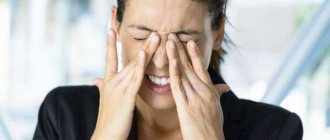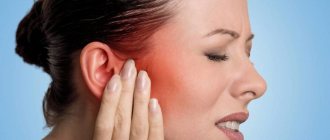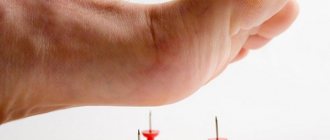If, after a long stay in the cold, aching toothache appears, accompanied by twitching, then, most likely, the dental nerve was cold. To deal with the problem, you need to understand which area is affected.
The fact is that teeth should not react to temperature changes, so they will not hurt when hypothermia occurs. Painful sensations may occur due to a pathological process that occurs in the inside of the tooth. The fight against infection should be entrusted to an experienced specialist.
Where exactly is the dental nerve located?
This question can be easily answered by considering the structure of the tooth. The top layer is the enamel, which covers the dentin. Next comes the central part of the tooth, filled with pulp, which in turn contains those same nerves and blood vessels. Small nerves form a kind of ball in the pulp. There are as many large nerves in a tooth as there are root processes in the tooth. Nerve disease indicates that destructive moments have reached the tooth, and pain signals that the problem must be solved immediately.
Symptoms
The symptoms of a cold dental nerve are as follows:
- sensitivity in the eyes, forehead and eyelids;
- aching pain in the jaw;
- shooting nature of pain;
- an increase in pain when teeth come into contact with cold food.
The inflammatory process that occurs in the nerve of the tooth occurs when pathogenic microbes enter the pulp. Inflammation is the main cause of sharp and throbbing pain during temperature changes or mechanical pressure. Sometimes pulpitis extends beyond the boundaries of the tooth root, which is complicated by periostitis or periodontitis. The main difference between pulpitis and periodontitis is the absence of a purulent sac and swelling.
If the dental nerve is really cold, it is better not to ignore the symptoms. In this case it is required. Otherwise, the consequences may be unpredictable. In the absence of proper treatment, the disease will become purulent, leading to tissue necrosis. This entails the death of the dental nerve. Ultimately, the pain subsides, but the inflammation spreads to nearby tissues.
What caused your head to blow?
If your head felt a bit drizzly, most likely you were in a draft. The main reasons why hypothermia occurs are presented below.
Even in the summer heat, you can feel the air on the left or right side of your head. If you work in an office or are in a house with the air conditioner on all the time, you should not be surprised when painful symptoms occur on the side of your face and head where it is located.
We are constantly in a hurry and, having washed our hair in the morning without drying it properly, we rush to work or run errands. We rushed out into the street, and this is the result - our wet head was blown by the wind.
Unpleasant symptoms appear: temperature 37 and above, shooting in one ear, pain in the left or right side of the skull and ear. All this is due to the fact that it blew.
Are you used to ventilating a room by opening doors and windows at the same time? The result will not be long in coming. If you add cold drinks and ice cream to such conditions, you may not be surprised that both parts of your skull are blown out. The back of the head and neck may also be affected.
To avoid chilling the nerve on your head, leave the room during ventilation.
A common cause of a painful condition is that the head was blown in the car. This is a consequence of opening all the windows in the car at once.
It is wise not to open all the windows at the same time, but to lower the glass only on one side, and only halfway. And don't lean out of the window while driving.
Causes
Detailed causes of dental nerve inflammation:
- Caries is an advanced case when the destructive process has reached the pulp;
- Fracture, chip, tooth injury, which leads to damage and further destruction;
- Incorrect treatment. When treated by an unqualified dentist, an infection may occur in the tooth;
- Poor quality materials during treatment. In this case, it may be caused by bad drugs or drugs that cause inflammation;
- Improper processing when installing dentures;
- Penetration of infection into the tooth due to other diseases. For example, with sinusitis, osteomyelitis, or the integrity of the tooth root may be compromised through root canals.
Diagnostic methods
If you complain of pain near the cheekbones when yawning, eating, or talking, a visual examination is performed. Afterwards, radiography, MRI, ultrasound, and ECG are prescribed (if heart failure is suspected). The disease is differentiated depending on the type of origin:
- dental problems;
- neurology;
- pathology of the cardiovascular system;
- ENT diseases;
- injuries;
- neoplasms.
Diagnosis of cardiovascular, bone and ENT pathologies is carried out on the basis of analyzes and examination data. X-rays and MRIs will help identify why the skin on the face or a tooth hurts, why the mouth cannot open, and identify tumors.
Oncology is much more difficult to diagnose. Tests for tumor markers, tomography and other modern methods help with this. Based on the diagnostic results, a treatment tactic is selected, the duration of which depends on the degree of neglect of the disease.
What to do?
What to do if the dental nerve has caught a cold - first of all, it is necessary to destroy the bacteria. This will prevent further spread of the infection. A dentist can help you deal with this problem. If, due to certain circumstances, it is not possible to visit a dental clinic, you can alleviate the condition at home.
Heating the affected tooth is strictly prohibited, as this will contribute to the spread of infection to the periodontal areas. In this case, hot compresses are unacceptable. A scarf that should be wrapped around your cheek will help overcome the pain.
To relieve painful symptoms, you can use the following medications:
- lidocaine;
- dexalgin;
- coffeedon;
- oxadol;
- citrapar;
- indomethacin
Folk remedies
You can relieve tooth pain with a soda solution. To prepare it, you will need to add 1 tsp to a glass of warm water. baking soda. To enhance the effect, you can additionally use a pinch of salt. The product is used to rinse the mouth.
A tincture based on birch buds has a good analgesic effect. To prepare it, you need to take 25 grams of buds, pour pure alcohol (100 ml) into them and leave the product to infuse for 8 days. The finished tincture is used for lotions. To relieve pain, soak a small piece of cotton wool in an alcohol solution and apply it to the gum of the disturbing tooth.
Garlic will also be useful if someone has a toothache. What to do in such a situation? You need to cut one clove lengthwise and apply one of the pieces to the gum. The procedure may not be pleasant, but the toothache goes away instantly.
Contents of the article: classList.toggle()»>expand
By the term “tooth hypothermia,” dentists usually mean local hypothermia of the dental nerves - an unpleasant condition accompanied by constant pain.
What are the causes and symptoms of this condition? What to do if a tooth hurts after hypothermia and how to treat it? How serious are the potential consequences of the pathology? You will read about this and much more in our article.
Symptoms and manifestations of dental hypothermia
The symptoms of hypothermia directly depend on the depth of cold exposure in the specified location.
Under the layer of enamel and dentin there is the central part of the tooth, which is filled with pulp - it, in turn, consists of blood vessels and nerves, forming a spherical “tangle”. If hypothermia has not reached it (i.e. hypothermia is only superficial and short-lived), then a person can only feel an unpleasant sensation in the oral area, slight numbness localized in the dentition.
If low temperatures begin to directly affect the pulp, then a characteristic symptom complex with all its negative manifestations is formed.
Hypothermia of the tooth is accompanied by the following symptoms:
- Aching pain in the jaw area. It does not disappear over time and intensifies with chewing activity;
- Painful “shots”
. Occurs upon any contact with cold or too hot food, and is expressed in an instant increase in pain until unbearable; - Increased sensitivity of neighboring locations. The patient may feel discomfort in the forehead, eyelids, eyes, nearby skin, sometimes the pain even radiates to the neck;
- Slight increase in temperature
. Diagnosed in the late stages of development of the post-reactive stage of the pathology, it is usually associated with a secondary bacterial infection that has penetrated into the localization due to a decrease in local immunity and a long-term absence of any therapy with pulpitis extending beyond the boundaries of the root and the formation of a purulent sac with swelling.
Treatment of tooth hypothermia
If a tooth becomes too cold, it is imperative to visit a dentist. If this is temporarily not possible, then at least start adequate therapy, but do not leave the problem to chance, due to the fairly rapid formation of a number of complications.
First aid procedures for dental hypothermia include:
- Immediately stop contact with cold. It is necessary not to open your mouth, if possible, get out of the cold into a warm, heated indoor room;
- In case of dental hypothermia, it is forbidden to warm the localization,
either with compresses or liquids, or with food, so that the restoration of the temperature regime is as natural as possible. In case of severe hypothermia, it is rational to apply a heat-insulating bandage through the chin made of layers of cotton wool and gauze to the jaw; - Using home remedies. In the reactive stage, after hypothermia, you can use a solution of 1 teaspoon of soda and salt, which is thoroughly mixed in 1 glass of water at room temperature, then rinse your mouth.
Medications
To prevent inflammation of the dental nerve from hypothermia, especially against the background of acute pain, it is rational to use special medications.
Similar articles
Groups of medications for tooth hypothermia:
In case of flux formation from hypothermia, which in our case is a complication of cold pulpitis, it is imperative to consult a dentist - we are talking about a direct secondary bacterial infection, so the treatment procedure, in addition to taking antibiotics (most often Amoxiclav, Levomycetin or Ciprofloxacin) includes microsurgery with an incision of a purulent formation and thorough cleaning of the cavity.
Folk remedies
Folk remedies can be used for additional treatment of tooth hypothermia only in the absence of serious complications in the form of gumboil, periodontitis, periostitis and other pathologies, and it is imperative to consult a dentist.
Traditional medicine recipes:
How to treat the disease and what can be done at home
Analgesics will help eliminate acute pain, but taking them will not solve the problem, but will only delay the recurrence of the symptom. You can take the following drugs: Analgin, Ketanov, Dimexide, Dolaren.
In addition to drug treatment, the use of folk remedies is indicated, for example, for dental diseases, you can rinse your mouth with a soda solution (1 teaspoon of soda per 1 glass of water), and for inflammation, apply warm (not hot) compresses with chamomile to the affected area. But before using any folk remedy, you need to consult a doctor, since pain in the jaw may indicate a very serious pathology, the improper treatment of which can lead not only to complications, but also to death.
Treatment options at the clinic:
- Dislocation. The specialist will straighten the jaw and apply a fixing bandage.
- Injury. The doctor will order an x-ray to rule out a fracture and apply a bandage.
- Fracture. Splinting, intermaxillary fixation or osteosynthesis with titanium plates (for an open fracture) are performed.
- Osteomyelitis. The dentist removes the diseased tooth, opens the purulent lesions and prescribes drug therapy.
- TMJ dysfunction. Treatment for patients who have pain in the jaw joint near the ear does not involve surgery. This pathology can be effectively treated using electrical impulses. For this, a special device is used - a myostimulator. One therapeutic procedure lasts about 40 minutes. In addition, medications, massage and other measures are prescribed at the discretion of the doctor.
- Diseases of the ENT organs. Therapy is carried out using antiviral, painkillers, and antiseptic drugs.
- Inflammation of the joint sac, dental nerve, neuralgia. Rubbing, drug therapy, and applying compresses to the problem area are indicated. The dental nerve is usually removed and the canals are filled.
Only a doctor can determine the true cause of the pain syndrome and prescribe appropriate treatment. Theoretical knowledge about the possible causes and signs of diseases that provoke uncomfortable pain can only help the patient correctly determine which doctor to go to.
When acute pain occurs from the jaw joint to the ear, it is worth reducing the impact on the affected area.
Following these simple recommendations will help with this:
- try not to open your mouth wide, thus reducing the load on the joint;
- It is worth eating food in small portions, and it should not be very hot or very cold;
- The food consumed should not be difficult to chew, preferably soft; if the pain syndrome is severe, the food is preferably liquid;
- avoid pressure and mechanical impact on the painful area;
- exclude the possibility of hypothermia.
These precautions can reduce the number and force of chewing movements and reduce the load on the jaws.
| Main complaints | What to do to alleviate the condition |
| Chewing pain, stiffness, clicking or catching of the jaw | take a pain reliever; reduce or eliminate the load on the jaw. |
| Pain syndrome in the jaw and ear | Taking a pain reliever |
| Edema and swelling of the temporomandibular joint | Short-term use of cold |
| Dental pain | taking painkillers; rinsing with antiseptic drugs; herbal rinses with an antiseptic and soothing effect. |
| A significant increase in body temperature, the appearance of symptoms of viral mumps in the child | use of antipyretic drugs; fastest house call. |
Prolonged pain that does not go away is a reason for examination
If you simultaneously complain that your jaw and ear hurt, you need to see a doctor as soon as possible. A dentist or ENT doctor is suitable for the initial visit; they will help differentiate the cause of the pain and, if necessary, refer you to other specialists.
https://www.youtube.com/watch?v=xkMxtCune0E
Every person knows himself better than any doctor. Therefore, when the first signs of illness appear, you can roughly guess what may be causing your poor health.
Source
Complications and consequences
Dental hypothermia can cause a number of serious pathologies, both at the local and systemic levels, especially in the absence of qualified, timely treatment.
Possible consequences:
- Periodontitis. It is an inflammatory process in the periodontium with disruption of the ligaments that hold the tooth in the alveolus. In addition, against the background of pathology, bone tissue resorption and cyst formation occur;
- Pulp necrosis
. Partial or complete destruction of the soft structures of the pulp, with the formation of systemic purulent-fibrinoid processes;
- Periapical abscess. The acute phase of an infectious secondary lesion is a direct continuation of pulp necrosis, which spreads through the alveolar bone to adjacent tissues;
- Purulent sinusitis
. Systemic complication with inflammation of the mucous membranes of the paranasal sinuses and stagnation of pus in them; - Meningitis
. Inflammatory process of the meninges caused by a generalized spread of infection in the oral cavity; - Brain abscess
. Secondary focal accumulation of pus in the brain caused by bacteremia in advanced forms of bacterial infections; - Other pathologies, often life-threatening.
Often, after being in the cold for a long time, a person may develop a toothache. Why does this happen, and how can cold cause pain? The fact is that the dental nerve can get cold. However, healthy teeth do not react to cold or temperature changes. If a tooth begins to ache in the cold, this indicates the presence of a pathological process inside it. This situation requires treatment. Let's look at what to do if the tooth nerve is cold and how to recognize the disease.
To understand where the nerve is located, you need to know the structure of the tooth. Its top layer consists of enamel, the next layer is the dentin shell, which is hidden under the enamel.
Attention! In the central part of the tooth there is soft tissue - pulp. It is dotted with many nerves and vessels. Larger nerves are connected to the root processes (as many roots as there are nerves). Small nerves together with blood vessels are collected into a neurovascular bundle.
Any pain in the dental nerve is associated with the development of a pathological process inside the tooth, and therefore requires medical intervention. And the stronger the pain, the sooner you need to seek help from a dentist.
Nerves, as well as lymphatic and blood vessels, are part of the fibrous substance that fills the entire cavity in the tooth, represented by soft tissue. After their removal, the tooth ceases to be alive.
If the cause of pain is joint problems
Disturbances in the functioning of the temporomandibular joint can cause pain spreading from the jaw to the ear. Patients describe their sensations as if their ear hurts when they move their jaw. Inflammatory processes occurring in the joint limit its normal motor ability.
Diseases such as arthritis and arthrosis affect joints; these degenerative phenomena destroy joint tissue, causing the patient a lot of inconvenience. The pain is more often described as aching, pressing. There is a feeling of a joint clicking when moving, a feeling of clinging. After sleep, stiffness in movements is felt. When pressing on the joint area, pain occurs.
Inflammation can occur due to hypothermia of the joint area; it is not uncommon for a person to be blown away. Along with the joint, other organs, such as the ear and nerves, can also become hypothermic. Hypothermia can cause problem teeth to ache.
Photos and videos in this article will demonstrate the nature of the origin of pain during degenerative processes in the joint.
There are several standard causes of pain in the jaw near the ear. They can appear separately or in combination. Sometimes one painful condition turns out to be a consequence of previous ailments: for example, untreated caries can precede inflammatory processes in the gums and contribute to nerve irritation.
Neuralgia is an inflammation of the nerve plexuses, which is the result of pathological processes in the surrounding tissues. Arthrosis is the thinning and degradation of the cartilage tissue of the jaw joint, requiring immediate measures to restore body functions.
- Neuralgia is often unilateral. Discomfort occurs after complex extraction of a chewing tooth. A painful impulse can be triggered by brushing teeth, pressing on a problem area, the onset of a cold, or hypothermia. Neuralgia develops as a result of prolonged irritation of peripheral nerve endings during long-term treatment of dental pathologies.
- Inflammation of the glossopharyngeal or trigeminal nerve often occurs as a result of demyelinating processes accompanying multiple sclerosis, Devic's opticomyelitis - in this case, neuralgia is considered secondary.
- Post-traumatic conditions with nerve pinching are possible.
- Hypothermia remains a common cause of nerve inflammation: you should take care of your face in the cold frosty wind, and washing your face with ice water is simply dangerous.
- Malocclusion can also cause neuralgia or arthrosis of the maxillary joint.
- Destructive processes and wear of cartilage tissue in the jaw joint, characteristic of arthrosis, can cause a lot of concern.
In parallel with pain during chewing and discomfort in the jaw near the ear, swelling or hyperemia of the skin may occur.
Impacts without displacement of the joints of the bones of the jaw apparatus or with minor subluxation, bruising of soft tissue areas lead to temporary painful sensations during chewing. Sometimes such conditions manifest themselves as aching pain in the ear.
Caries
Often the cause of pain of unclear localization is advanced caries of the upper molars.
It can develop in a tooth covered with an old, deformed crown; the damage is often invisible from the outside, but the destructive process inside the tooth has already started.
The pain “spreads” over an indefinite area, and it is difficult to determine its underlying cause. It becomes difficult to chew, the jaw in the ear area hurts.
This option is not excluded for young people. During teething, the dental crown damages the gums, creating significant discomfort. The pain can have different localization.
During this period, the formation of the correct bite occurs. If there is significant pain, the doctor may loosen the structure.
Osteomyelitis of the jaw
The disease is characterized by changes in bone tissue and manifests itself with a variety of symptoms, including pain in the ear area. Sometimes sharp bursts of pain resemble otitis media. But osteomyelitis most often develops in areas of the lower jaw; only 25% of diagnoses occur in the upper jaw. This is an extremely dangerous disease!
Carotidynia
This is one of the types of migraine, the nature of its occurrence is little studied. Paroxysmal pain covers the upper jaw, surrounds the ear, then spreads to the face and other parts of the head.
Oncology
Tumors of various kinds can also provoke pinched nerves and other inflammatory processes. Therefore, you should not ignore the rolling pains that radiate to the upper jaw or ear and subside for a while.
Often pathological processes develop asymmetrically. Therefore, pain can only appear on the left or right side. Aches in the joint, discomfort near the ear on one side are characteristic of all types of neuralgia.
- With arthrosis or primary dysfunction of the jaw joint, it is extremely rare that the destructive process involves both joints. The painful condition often occurs if a person constantly overloads one side.
- The root cause may be improper prosthetics or lack thereof: after removing a tooth, the patient is often in no hurry to see an orthopedic dentist to install crowns or an implant. But a gentle attitude towards one part of the jaw apparatus provokes an unbearable load on the delicate little other joint. Then a loud cracking sound occurs when you try to open your mouth wider, and the jaw next to the ear hurts only on the left or right.
- If caries develops, inflammatory processes cover the gum tissue, then the focus in 80% of all diagnosed cases is also located only on one side. The same manifestations are characteristic of the growth of the last - eighth - molars.
- Injuries and manifestations of osteomyelitis provoke disorders only on the right or left. And wearing braces can cause symmetrical pain.
Completely unexpected manifestations are possible:
- Pain in the jaw on the left may be a symptom of angina or a pre-infarction condition. Blood circulation is impaired, so vasospasm occurs.
- The right side reacts sharply to standard stimuli.
If the cause is injury, then the pain will be either on the injured side or on the opposite side - the patient can spare the injured part and put an extreme load on the healthy jaw.
If the jaw joint near the ear hurts, treatment requires first identifying the source of the pain. The problem is not always caused by diseases of the jaw.
Without an examination by a specialist, it is definitely impossible to answer why the jaw hurts near the ear.
We suggest you read: What not to eat when you have braces
The cause of the pathology can be various damage to soft and bone tissues, from correction of malocclusion with braces to a malignant tumor.
Among the common causes of pain in the jaw are:
- The need to wear braces or dentures. Correction of the bite, normal placement of teeth is accompanied by pain for some time.
- Wisdom tooth growth. Deviation from the accepted norm (for example, an incorrect angle relative to the jaw) causes damage to the soft tissues and the jaw itself. When chewing, the pain intensifies.
- Surgical intervention (removal of a cyst, the tooth itself) may cause pain for some time, but if it does not go away after complete healing of the wound, there is reason to assume the development of a new disease.
If pain in the jaw is not associated with bite adjustment or surgery, then it is recommended to visit the dentist as soon as possible.
- Arthrosis of the temporomandibular joint leads to stiffness and pain when opening the mouth. While chewing food, pain in the jaw is aggravated by noise in the left ear.
- Arthritis. Inflammation of the jaw joint is accompanied by severe pain and a crunching sound when chewing.
- Joint dysfunction. The pain manifests itself when trying to chew, tightly connecting the upper and lower jaws. The sensations are transmitted to the ear area and cheek area. As soon as you open your mouth wide, clicks are clearly audible.
- Gingivitis. Inflamed mucous membranes of the gums react sharply to attempts to chew rough food.
- Osteomyelitis. Pathogens are considered to be pathogenic microorganisms that have penetrated the bone tissue. As a result of their activity, a purulent process begins in the bone, which causes uncomfortable sensations in the form of pain in the ear on the left side. Because of this, during chewing, pain in the jaw increases noticeably.
Jaw injuries
If your jaw hurts near your ear on the left, and it hurts to chew, it may be the result of injuries. The severity of the damage determines the speed of disappearance of the symptom that prevents you from chewing calmly on one side. The mildest injury is considered to be a bruise. Acute pain and swelling leave the owner after just a few days.
A fracture is considered a fairly dangerous jaw injury. In addition to severe pain, hemorrhage under the skin and swelling, the patient experiences serious difficulty opening his mouth. As a result of a fracture of the upper jaw, hemorrhage may be observed in the orbital area, which leads the specialist to suspect a fracture of the base of the jaw.
ENT diseases
The jaw on the left near the ear may hurt so much that it hurts to chew as a result of advanced purulent processes or inflammation in the sinuses themselves. Among the ENT diseases that can cause pain when chewing on the left side, inflammation of the tonsils and tissues close to them is also noted.
Mumps or mumps is a viral inflammation of the parotid gland, making it painful, which is felt in the area of the upper and lower jaw, ear.
Additionally, the patient's temperature rises, weakness, and swelling on one side are observed. The disease often occurs in childhood.
Caries of the jaw, which is caused by the movement of infection along with blood from the affected tooth to the jaw. This phenomenon usually results from injury. In addition to painful sensations in the jaw, which tend to intensify during chewing, a person observes other changes in his body:
- high temperature, capable of reaching 40 degrees;
- swelling under the skin;
- asymmetry, distortion of the face due to severe swelling;
- examination of the oral cavity makes it easy to identify the “culprit”, which necessarily has pulpitis or a significant carious defect;
- inflammation of the submandibular lymph nodes.
Signs of hypothermia of the dental nerve
If a person has a cold on the dental nerve, this can be recognized by the following symptoms:
- aching pain is felt in the jaw area;
- the pain may be shooting in nature;
- increased sensitivity of the eyes, eyelids, forehead;
- When eating cold food or drinks, the pain intensifies;
- smiling can also be accompanied by pain.
Important! The cause of the pathological process affecting the dental nerve is pathogenic bacteria that penetrate the pulp. Changes in temperature or slight physical impact cause throbbing or shooting pains. If the pathological process spreads beyond the dental nerve, periostotitis (flux) or periodontitis may develop. The presence of pus and swelling distinguishes periodontitis from pulpitis.
Both women and men are equally susceptible to hypothermia of the dental nerve. Every person, regardless of age, can get a cold in their teeth. What to do if this happens? You should immediately seek help from a dentist. If this is neglected, various complications are possible. The inflammatory process will spread to nearby tissues, causing suppuration. As a result, the dental nerve may simply die. Over time, the tooth will stop hurting, but this does not mean that the problem is eliminated. Inflammation will remain, in addition, it will capture more and more new tissues, spreading the infection. That is why it is so important to eliminate the source of inflammation in time.
Periostitis in common parlance – gumboil – is the rapid spread of pus in the gum tissue. A dangerous disease, the consequences of which can be replenishment of teeth, gums, and the whole body.
Pain in teeth due to cold
Colds in themselves are unpleasant - after a person has caught a cold, been in a draft for a long time, or has been in contact with someone who has ARVI, the whole body begins to ache, the temperature rises, the nose runs, and the throat gets a sore throat. The situation is often complicated by the development of secondary infection and sinusitis if treatment is not started in time.
But when your teeth hurt when you have a cold, not all people with a cold experience this phenomenon.
When the jaw begins to ache, and all teeth, even healthy ones, experience tedious pain, a person experiences a natural feeling of fear.
Today we need to figure out why a sharp toothache sometimes begins against the background of a cold, how to cope with this phenomenon, what medications and folk remedies are useful for this.
Causes of toothache development
Can teeth hurt when you have a cold? Definitely yes, among the people this phenomenon has acquired the term “dental cold”, and although doctors do not make such a diagnosis, the phenomenon does occur.
There may be several reasons why teeth hurt during a cold; they are directly related to the disease itself or act as a consequence of infection.
So, the main factors suggesting the development of toothache during a viral or bacterial infection.
Sinusitis
If the first signs of a cold and runny nose are ignored by a person, sinusitis develops as a result of the layering of a secondary bacterial infection - inflammation of the paranasal sinuses. Against the background of this disease, the patient’s teeth ache along the entire length of the jawbone, and purulent bags may form on the gums. They weigh down the roots of the teeth, causing severe pain.
Respiratory infection
When a person’s feet are very cold or he has spent a long time in frosty, windy conditions, a cold will not be long in coming, especially if the immune system is weakened.
At this time, the airways and paranasal sinuses become inflamed. The mucous epithelium becomes covered with sputum, which is difficult to remove.
It interferes with normal breathing and creates increased pressure in the sinuses, resulting in a person's jaw pain.
During a cold, a severe runny nose begins, which is not so easy to stop. The nose is clogged, the patient has to breathe through his mouth, the situation is aggravated by coughing - the mucous tissue of the oral cavity dries out. For this reason, sugar and acids intensively settle on the surface of the teeth, damaging the enamel layer; the process is accompanied by severe discomfort and aching pain in the jaw area.
Signs of poisoning
Another reason why teeth can hurt is a severe case of influenza. A viral infection often causes nausea and vomiting, upset stomach, and diarrhea. The stomach intensively produces acid, which is thrown out during vomiting, and its remains actively corrode the enamel layer of the teeth.
What to do if your teeth hurt due to a cold? The most important thing is to establish the root cause of the phenomenon and deal directly with it
To reduce unpleasant symptoms, you should rinse your mouth more often with saline or soda solution, potassium permanganate or Furacilin. This way, you can at least remove acid residues from the surface of the teeth and wash away bacterial plaque from the mucous membrane.
Why does the disease occur?
There are several reasons that can cause the disease:
- untreated deep caries, turning into pulpitis;
- injuries, chips, broken teeth;
- poor-quality treatment that caused a secondary infection;
- treatment and filling of teeth with low-quality materials or medications;
- poor-quality tooth treatment during prosthetics;
- penetration of infection into the tooth caused by other diseases.
Deep caries is the last stage of the carious process, it is expressed in the destruction of the tooth crown, the spread of infection in the soft tissues of the tooth, pain when exposed to temperature, mechanical or chemical stimuli.
Disease prevention
Very often, the cause of hypothermia of the dental nerve is untreated caries. This is due to the fact that any impact on the nerve, including cold, can only cause harm if the tooth is already damaged.
Attention! Healthy teeth do not react to temperature changes. To prevent tooth hypothermia, it is necessary to treat caries in a timely manner, as well as undergo preventive examinations, even if nothing hurts. Maintaining oral hygiene is of great importance in the prevention of dental diseases.
It is very easy to chill the tooth nerve in cold or windy weather. To protect yourself from this, you need to choose the right clothes for the cold season. A hat, scarf, and high collar will help protect your teeth and other organs from hypothermia.
Everyone has dental problems at one time or another. You need to take care of them very carefully and it’s not just about cleaning, but also about the necessary protection. Healthy teeth are not very sensitive to changes in the weather; hypothermia does not affect them, unless there is some kind of internal inflammatory process. Still, when walking in the cold season, you need to dress carefully, you can’t eat on the streets, otherwise you can get a cold on the dental nerve, because you may not even know about problems with your teeth.
The last thing people think about when staying in the cold for a long time is their teeth. This is understandable, everyone still remembers their childhood experiences, when in the cold they could ride and laugh to their heart’s content without any consequences in the form of toothache. In children, dental problems are most often quickly resolved, but adults may not notice the onset of an internal inflammatory process. And if, after a long walk, a tooth suddenly aches, and twitching is also felt, they are surprised to learn that it turns out that the nerve is cold. And the questions begin, my nerves get cold, what to do.
First, you need to determine which area was exposed to low temperatures in order to identify the infection and treat it. Therefore, it is unlikely to be possible without the help of a qualified doctor.
But general knowledge will not be superfluous, in addition, certain folk remedies will help in providing first aid to disinfect the damaged area.
If your tooth has caught a cold - contact a specialist
What to do if your tooth has caught a cold - consult a dentist, this is a sign of the presence of a pathological process; ignoring such symptoms is a big risk. Simply using painkillers will only provide temporary effects. Well, the answer to the question, is it possible to catch a tooth cold? It is possible if there are any problems. A person may not know about the presence of the latter, therefore, when the first signs appear, it is better to seek qualified help.
What is a nerve and where is it located? A nerve is one of the organs; if a nerve is removed (in a tooth it is located in the pulp), it is considered, in simple layman’s terms, non-living. Feelings become inaccessible. The tooth itself consists of enamel, dentin and the inner, central part. There is, of course, not just one nerve—there are as many of them as there are processes. If a tooth begins to ache, it means that the inflammatory process has reached the central part.
. You need to see a doctor urgently, otherwise you may lose your tooth.
Trigeminal neuralgia (trigeminal neuralgia)
All rights to the materials posted on the site are protected by copyright and related rights laws and cannot be reproduced or used in any way without the written permission of the copyright holder and an active link to the main page of the Eva portal.
Ru www. The editors are not responsible for the content of advertising materials. Agreement to terms of use. Our website uses cookies to improve your experience and make the site more efficient. Disabling cookies may cause problems with the site. By continuing to use the site, you agree to our use of cookies.
Close navigation Eva. About the project All rights to materials posted on the site are protected by copyright and related rights laws and cannot be reproduced or used in any way without the written permission of the copyright holder and an active link to the main page of the Eva portal. Password recovery. New User Registration. Service Use Agreement. Home Archive The facial nerve has caught a cold.
Message It seems that the facial nerve has caught a cold, or whatever it is called. It seems like nothing, after eating I don’t want to live - it’s starting to feel terribly painful. Ketanov seems to save him a little bit. How can we escape from this scourge? Does anyone know how to treat it? Fuck you! To a neurologist. This is serious.
He is undergoing full treatment. Pills, injections, physio. Don't panic! You make compresses: first, apply a warm compress for a minute, you can pour the cereal into a sock and heat it in the microwave, then take a break for a minute and apply a cold compress for a minute, freeze the ice and put it in a bag, and so on several times over the course of 2 days, the nerve will calm down.
Apply it in the cheek area, under the temple, where the three branches of the trigeminal nerve intersect. In general, if in the next. You need to see a good neurologist, if you don’t treat it, you could go crazy. The neurologist prescribed me physiotherapy, finlepsin, milgamma injections, dexalgin, diclofenac, nootropil in injections, in short, extensive treatment, but at night I warmed my face with salt, because it could warp, and you’ll be like guamplain.
As a quick remedy, I can recommend applying Menovazin - this is such a burning water - it warms and goes away. Close navigation Read EVA. RU on social networks. Thanks, later.
Symptoms and signs
If the dental nerve is cold, here are the main symptoms:
- The pain itself is constant and aching in nature. Sensations may spread to the jaw, forehead and eyelids;
- painful sensations can also be quite intense, but only for a while. That is, it can be a shooting pain.
- if cold foods are consumed, the discomfort becomes more intense.
If the dental nerve has caught a cold, what should you do? First you need to understand the mechanism of pain. You need to understand that painful sensations already signal the emergence of a problem that cannot be ignored. After all, only pathogenic microbes that have reached the nerve can create such unpleasant sensations. Exposure to low temperatures only becomes a catalyst that reveals the presence of negative processes. You need to see a doctor urgently.
No self-medication methods will help in such a situation; only qualified treatment is needed. Even if the pain subsides, this does not mean a cure, but that the process has spread to other tissues. This means that the nerve itself has already died and the tooth cannot be completely restored.
What to do if your ear is blown and it hurts
You can get a cold in your ears not only in the cold season - it is quite likely to suffer from the symptom in the summer. Ear pain can be caused by strong winds, drafts, or cold air from an air conditioner. Therefore, be careful in any weather.
What to do if your ear blows? Of course, first of all you need to go to the doctor. Delay and self-medication for ear pain can be dangerous to your health. However, there are situations when visiting the hospital is not currently possible, for example at night. What to do in this case?
Carry out the following manipulations:
- Take painkiller medicine.
- If there is no fluid coming out of the ear and there is no temperature, you can warm up the sore spot a little. To do this, they most often use a heating pad or a bag of warm salt.
- You can insert a cotton swab moistened with boric alcohol into the ear canal.
It is highly not recommended to prescribe medication yourself. Better wait for the doctor's comments.
Note that ear pain can be a symptom not only of inflammation, but also of other dangerous diseases. Also, unpleasant sensations can appear due to sinusitis, inflammation of the tonsils, and neuralgia.
Therefore, if the temperature rises and the pain only increases, immediately call a medical team home.
Causes of the disease
Tooth pain when exposed to low temperatures is a sign of nerve inflammation
Pain when exposed to low temperatures is a sign of inflammation. Reasons that can cause this inflammation:
- advanced caries, which has reached the most severe stage;
- damage to tooth tissue, which leads to destruction of the organ itself. This can be a consequence of even the most minor microtraumas and chips. And fractures cannot be ignored at all;
- a consequence of unqualified therapeutic influence. The patient may not notice this process. The infection appears as a result of treatment, if the doctor is not sufficiently qualified, signs of inflammation may not be visible if the affected area is difficult to access;
- a qualified doctor uses only proven means. Even if the treatment process with an untrustworthy doctor was successful, he may have used low-quality materials. In this case, an unpleasant disease such as pulpitis may develop;
- if there are crowns or implants, the reason may be in them. More precisely, in violation of the installation process of these structures, in the use of materials that cause inflammation;
- The infection can also penetrate from the body. In case of diseases of the nasopharynx, pathogenic microbes may well penetrate into the pulp.
Inflammation of the trigeminal nerve
All rights to the materials posted on the site are protected by copyright and related rights laws and cannot be reproduced or used in any way without the written permission of the copyright holder and an active link to the main page of the Eva portal. Ru www. The editors are not responsible for the content of advertising materials. Agreement to terms of use. Our website uses cookies to improve your experience and make the site more efficient. Disabling cookies may cause problems with the site.
Principles and stages of treatment
If these symptoms are recorded and they do not go away, you need to examine the oral cavity. It may be possible to detect the source of inflammation. Everything should be done to stop the process, to remove bacteria and reduce their activity.
Seeing a doctor is mandatory. But if the visit is postponed for reasons beyond the patient’s control, measures must be taken to relieve inflammation. This will also help cope with pain and reduce the intensity of unpleasant sensations.
Under no circumstances should you apply heat to an inflamed nerve.
There are a number of measures you can take at home. Under no circumstances should you heat the tooth itself or the area of inflammation directly. The infection may spread to other nearby areas. Therefore, compresses are prohibited. Wrapping yourself in a warm woolen scarf will help relieve pain. The use of medications is possible if their properties and effect are accurately established.
Only drugs that are sold without a doctor’s prescription are acceptable. Strong antibiotics should not be used
, since their action can be opposite, reverse. In addition, it is a potent remedy. For some categories of patients, their use may be prohibited altogether. So, while waiting for a new addition to the family, women need to monitor their health and prevent such dangerous substances from entering their bodies. Even if you cannot visit a doctor, such a simple consultation can be provided over the phone, by emergency doctors, for example. Therefore, it is better to ensure the safety of the drugs used by all available means.
There are also folk remedies to relieve inflammation and reduce the intensity of pain. Recipes should be tried and tested and only natural and fresh products should be used. Otherwise, the situation can only get worse.
Soda is known for its disinfecting properties, as is salt. You can use them in combination or separately. You only need to use a teaspoon of baking soda per glass of water. You can’t warm up the inflamed area, but you shouldn’t let it get cold either. Therefore, use warm water, or preferably room temperature. The solution must be sufficiently concentrated; the composition must be mixed well. Used for rinsing. You can use it as many times a day as necessary to relieve discomfort. There are no complications after use.
Infusion of birch buds - a folk remedy for treating an inflamed tooth
An infusion of birch buds also helps. Such a remedy is unlikely to be available at the right time, but it provides an excellent pain-relieving effect. The buds are infused with alcohol for at least a week. If there is a ready-made solution, it should be used for compresses.
Garlic is much more accessible. It is in every home, the product is inexpensive and completely natural, there is no doubt about it. There is no need to prepare garlic in any special way. Simply cut a clove and place a slice on your tooth or gum
. Experts say that the pain goes away almost instantly. It seems that this is not very pleasant, but the effect of the product is guaranteed and reliable.
No one has canceled preventive measures. When walking, you need to wear clothing appropriate to the time of year. You shouldn't eat on the street. If you already have discomfort, you need to get home urgently so as not to aggravate the situation. These are the most basic rules, but they must be followed.
Even during this period, you need to follow the rules of oral care. Of course, this is done whenever possible. If the pain is very intense, then you need to act carefully. Procedures can be canceled only if the patient is unable to eat food. Then you need to do everything for pain relief. If necessary, proven medications are used.
Garlic is effective for cold teeth
Hygiene can be achieved by rinsing. These procedures help not only to achieve a local anesthetic effect, but also cleanse the oral cavity and interdental spaces from food debris and pathogenic bacteria. It is better to postpone the use of brushes and floss, dental floss, and other means if it is painful.
If your tooth catches a cold, what should you do in this case? Many people face this question, because a cold caused by hypothermia can manifest itself not only with a runny nose, cough, sore throat, but also with unpleasant sensations in the teeth and gums. However, some attribute such symptoms to ordinary caries and are in no hurry to visit the dentist.
In this material we will find out whether it is possible to get a cold in a tooth, how to identify signs of such a condition and how to treat the disease.
If a patient goes to the dentist with a complaint about cold teeth, the specialist is obliged to find out the true cause of the symptoms accompanying the disorder, because there is simply no such thing as a dental cold in official medicine. Doctors say that dental and gingival tissue can indeed respond to hypothermia, but only if there are prerequisites for this.
When a patient says that he has a tooth cold, in most cases we are talking about inflammation of the nerve - pulpitis. Most often, this disease occurs due to the active activity of pathogenic microorganisms in the tooth cavity. The infection can remain in the pulp tissue for a long time and not manifest itself in any way, but in a person who is hypothermic and has a cold, it rapidly develops due to decreased immunity.
This problem often affects those who have untreated caries or chipped enamel. In addition, the cause of the violation may be poor quality work of the dentist who once performed the treatment. Finally, infection can penetrate into the pulp from diseased respiratory organs, spreading through the bloodstream.
The inflammatory process can occur not only in the teeth. If the nerve is not affected, then it is quite possible that you have caught a cold not in the pulp, but in the gum.
Gum tissue is damaged even more easily, since it is not protected by anything, and in a person with a cold, an infection in the gum area can develop in a matter of hours. This condition is called periostitis, but it is more popularly known as gumboil. Also, a cold tooth is at risk of periodontitis - inflammation of the soft tissues adjacent to the upper part of its root.
Before you begin treatment for a cold tooth or gum, you should make sure that your assumptions regarding the cause of discomfort in the oral cavity are correct. To do this, you need to know what signs accompany the so-called dental cold. These include:
- severe throbbing pain, which intensifies with mechanical and thermal effects on the tooth, as well as in the evening (typical of pulpitis);
- intense painful sensations of aching nature in the tooth and gums, radiating to the lower and upper jaw, eye socket, temple;
- swelling and redness of the gum tissue, increased discomfort when pressed;
- slight increase in body temperature (usually up to 37 °C).
A condition accompanied by such symptoms most often indicates the presence of dental problems, however, sometimes a cold tooth is not the only cause of illness. That is why experts do not advise diagnosing yourself and starting treatment at home without visiting a doctor and finding out why your teeth hurt and whether they really have a cold.
Mouth won't open
Hello! My father is 49 years old. In 2003, he was diagnosed with stage 1 cancer of the oropharynx (right side of the tonsil). Treatment was prescribed: targeted irradiation 60 gray and 3 courses of chemotherapy. At the end of the radiation course, the mouth began to close. In 2006, my teeth began to crumble, my mouth opened 2 cm.
We invite you to familiarize yourself with Burning in the mouth and tongue: the causes of which disease? Tongue burning: causes and treatment
, and in 2020 - already by 1 cm. The doctors said nothing to this, but prescribed chemotherapy, but my father refused to undergo it and is now not taking anything. We started training the jaw by massaging and opening the mouth 20 times 3 times a day. The mouth opened slightly from 0.5 cm. up to 1 cm, but when opening the jaw it cramps the muscles. Please tell me what exercises and procedures are necessary to develop the jaw muscles! Thank you!
Dentist's answer:
Hello. You need to show up for an in-person consultation at a special department in scientific centers, for example MGMSU, TsNIIS or regional ones.
Hello. Please tell me. A week ago I had my wisdom tooth removed on the right side. They removed it quickly and left the root before removing it, they didn’t take a picture. After the removal, my mouth began to open a few days later, but pain appeared at 7 degrees, I went and did an X-ray and saw that it took 2 hours They picked at my gum in the hope of pulling it out, but they didn’t pull it out.
Now my mouth doesn’t open, at most I can put in a small spoon. I prescribed antibiotic injections and a Metragil drip. I haven’t had a temperature for two days now, 37. But the pain in my throat is not enough, my lymphausil has become inflamed. He said that the root should be torn off by itself. I’m very afraid of the consequences, tell me if he can do it himself Should it be torn off or should it be removed somehow?
Hello, 2 days ago the right, bottom 8 was removed. The tooth lay in the gum bone, they cut it, drilled it into 3 parts, took it out an hour later and sewed it up. After the anesthesia wore off, it became terribly painful to swallow. The next morning, I discovered that the tonsil was swollen, and on the outside under the jaw it was also swollen and the pain went down the throat to the bottom of the kayak, it hurt to turn the head, the mouth opened 1 cm, with pain 2 cm. There was no swelling of the cheek, the site of tooth extraction does not hurt with light pressure
Hello, 2 days ago the right, bottom 8 was removed. The tooth lay in the gum bone, they cut it, drilled it into 3 parts, took it out an hour later and sewed it up. After the anesthesia wore off, it became terribly painful to swallow. The next morning, I discovered that the tonsil was swollen, and on the outside under the jaw it was also swollen and the pain was going down the throat to the bottom of the kayak, it hurt to turn the head, the mouth opened 1 cm, with pain 2 cm.
There was no swelling of the cheek, the site of tooth extraction does not hurt with light pressure, in the evening of the 2nd day the temperature rose to 38, I take antibiotics, painkillers and for allergies, I eat pureed soups, please tell me why it is so painful to swallow, on the 2nd day the pain and swelling does not subside. Is this normal? The doctor today told me to rinse with soda salt and iodine so that the swelling goes down.
Dear Boris! The symptoms that are bothering you can be explained by a complex tooth extraction, but given the presence of pain when swallowing, I would recommend contacting a therapist or ENT doctor. It is quite possible that we are talking about inflammation of the tonsil, which is not associated with tooth extraction, but has other causes.
We suggest you read: The floor of the face and teeth hurt
Events that occur simultaneously or sequentially are not always related to each other by a cause-and-effect relationship. Difficulty opening the mouth in this case is caused by trismus, a pathological spasm of the masticatory muscles. Repeated chewing movements contribute to the resolution of trismus.
Hello! On November 2, I went to clinic No. 9 to treat 47. After an X-ray, they said that 48 had been removed and needed to be removed. First they gave me an anesthetic injection. and they put a temporary filling on 47, then they injected anesthesia “for removal” and removed the 48th tooth. The gums were not sutured, no medications were prescribed. Immediately after removal, I applied ice, after 10 minutes, after examining, changing the cotton wool, I was sent home. I didn’t eat or drink anything that day after the operation. woke up 3.
11 from pain, blood was still spitting out (although 16 hours had passed). drank ketans. applied cold. there was no severe swelling. In the evening, pain began when swallowing, the temperature rose to 37.7. After each meal I took chlorhexidine baths. before going to bed there was something on the surface of the hole (I thought it was leftover food), I removed it carefully, without picking, treated with chlorhexidine, with a handy object, it turned out to be two fragments of a tooth.4.
11, the temperature returned to normal, the throat began to hurt more when swallowing, the swelling was not in the cheek area, but more under the jaw. The jaws did not open more than 2 cm. 5.11 the swelling has increased, without yellowness, neither the swelling nor the gums hurt, but when pressing from below, under the jaw, there is pain in the area of the removed figure eight. The pain when swallowing is just as severe. jaws open by 1cm Question.
Dear Marina! You should contact a dental surgeon without delay. Unfortunately, it is impossible to assess the clinical situation or make recommendations for treatment in absentia. If you have the opportunity to consult with metropolitan specialists, you can choose a doctor and make an appointment here.
Medicinal treatments
So, what to do if your tooth gets a cold? Many people try to cope with the main symptom of this disorder—pain—with the help of potent painkillers. However, you need to understand that this is only a temporary measure that can only be used as first aid until you see a specialist.
Anna Losyakova
Dentist-orthodontist
If a gum or tooth is blown out, and as a result an inflammatory process occurs, this condition requires mandatory treatment under the strict supervision of a doctor. Therefore, the first thing to do is to get to the dentist as quickly as possible.
Since cold teeth often really hurt, before starting treatment with a specialist, you are allowed to take medications that relieve discomfort. You can take Nurofen, Paracetamol, Ketorol, Tempalgin and other painkillers. Lidocaine can be used as a local anesthetic. It is generally not recommended to take them before consulting a doctor, as this can greatly complicate the diagnosis of the pathology.
Nurofen Paracetamol Ketorol Tempalgin Lidocaine
Before starting treatment, the dentist conducts a thorough examination and, if necessary, sends the patient for an X-ray examination of the affected area. As a rule, the inflammatory process is clearly reflected in the image, and the dentist can easily determine further treatment tactics. Thus, in the treatment of the dental nerve, either a surgical method is used, in which the dentist removes soft tissue, or a conservative method - with the use of antiseptics, non-steroidal anti-inflammatory drugs and antibiotics. Antibacterial agents may also be needed if gum tissue is damaged.
Anna Losyakova
Dentist-orthodontist
You should not delay treatment: the rapid development of the infectious process caused by simple hypothermia can lead to serious complications - up to the complete loss of the diseased tooth and tissue necrosis.
Damage to the temporomandibular joint
Joint diseases - arthritis, arthrosis, etc. - have recently affected more and more people. If earlier representatives of older generations were targeted, now even young people can face arthritis. With arthritis of the temporomandibular joint, it becomes jammed, and the pain appears near the ear near the temple and is aching in nature. When determining arthritis, instrumental diagnosis is necessary.
We suggest you read: Sore throat after wisdom tooth removal: why there is pain when swallowing, and what to do if the hood has been removed from the gums in the mouth
When the joints of the lower jaw are affected, pain can be felt not only in the ear area, but also in the cheek, temples, or even radiate to the forehead. When you chew, the pain intensifies; when you close your jaws completely, you hear a characteristic clicking sound. Arthritis has different pathogenesis: from malocclusion to infectious joint lesions. Self-treatment is fraught with serious complications.












